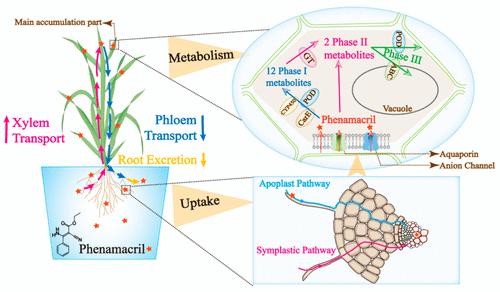当前位置:
X-MOL 学术
›
Environ. Sci. Technol. Lett.
›
论文详情
Our official English website, www.x-mol.net, welcomes your
feedback! (Note: you will need to create a separate account there.)
Phloem Redistribution of Pesticide Phenamacril in Plants Followed by Extensive Biotransformation
Environmental Science & Technology Letters ( IF 8.9 ) Pub Date : 2023-12-18 , DOI: 10.1021/acs.estlett.3c00862
Runan Li 1 , Jinhe Chang 1 , Xinglu Pan 1 , Fengshou Dong 1 , Guirong Wang 1 , Zhiyuan Li 2 , Yongquan Zheng 3 , Yuanbo Li 1
Environmental Science & Technology Letters ( IF 8.9 ) Pub Date : 2023-12-18 , DOI: 10.1021/acs.estlett.3c00862
Runan Li 1 , Jinhe Chang 1 , Xinglu Pan 1 , Fengshou Dong 1 , Guirong Wang 1 , Zhiyuan Li 2 , Yongquan Zheng 3 , Yuanbo Li 1
Affiliation

|
Here, we evaluated the uptake and biotransformation mechanism of the systemic fungicide phenamacril in hydroponic/soil–plant systems. Phenamacril was preferentially accumulated in shoots with the translocation factor up to 3.5 (or 6.9) in wheat (or rice) during 144 h of the uptake kinetic experiment. Apart from upward xylem translocation, phenamacril could also be redistributed from shoots to roots (0.4%) through phloem transport and then released into the rhizosphere surrounding solution (1.7%) through plant excretion via a split-root experiment. Then, 76.4% (or 70.4%) of phenamacril was transformed to 14 (or 12) metabolites in hydroponic-wheat (or hydroponic-rice) systems after 28 days of exposure, with nine of them first identified based on nontarget analysis. The proposed metabolic pathways included hydroxylation, hydrolysis, isomerization, dehydrogenation, deamination, dehydration, decarboxylation, reduction, and conjugation reactions, which were modulated by genes overexpression of metabolic enzymes (e.g., cytochrome P450). Notably, metabolite M-157 was predicted to be more persistent in environments and more toxic to rats and aquatic organisms than phenamacril by theoretical calculation. This study highlights that phloem transport and plant excretion may result in cycling chemical contamination, and the transformation products may possess elevated toxicities, thus should be considered in estimating the contamination of pesticides in crops and environments.
中文翻译:

农药非那丙烯利在植物中的韧皮部重新分布,随后进行广泛的生物转化
在这里,我们评估了内吸性杀菌剂非那丙烯利在水培/土壤-植物系统中的吸收和生物转化机制。在144小时的吸收动力学实验中,非那丙烯利优先积累在小麦(或水稻)的芽中,易位因子高达3.5(或6.9)。除了木质部向上易位外,非那丙烯利还可以通过韧皮部运输从芽重新分配到根(0.4%),然后通过分根实验通过植物排泄释放到根际周围溶液(1.7%)。然后,暴露 28 天后,76.4%(或 70.4%)的非那丙烯利在水培小麦(或水培水稻)系统中转化为 14 种(或 12 种)代谢物,其中 9 种是基于非目标分析首次鉴定的。所提出的代谢途径包括羟基化、水解、异构化、脱氢、脱氨基、脱水、脱羧、还原和缀合反应,这些反应受到代谢酶(例如细胞色素P450)基因过度表达的调节。值得注意的是,根据理论计算,代谢物 M-157 预计在环境中更持久,对大鼠和水生生物的毒性比非那丙烯利更大。这项研究强调,韧皮部运输和植物排泄可能导致循环化学污染,并且转化产物可能具有较高的毒性,因此在估计农作物和环境中农药污染时应考虑到这一点。
更新日期:2023-12-18
中文翻译:

农药非那丙烯利在植物中的韧皮部重新分布,随后进行广泛的生物转化
在这里,我们评估了内吸性杀菌剂非那丙烯利在水培/土壤-植物系统中的吸收和生物转化机制。在144小时的吸收动力学实验中,非那丙烯利优先积累在小麦(或水稻)的芽中,易位因子高达3.5(或6.9)。除了木质部向上易位外,非那丙烯利还可以通过韧皮部运输从芽重新分配到根(0.4%),然后通过分根实验通过植物排泄释放到根际周围溶液(1.7%)。然后,暴露 28 天后,76.4%(或 70.4%)的非那丙烯利在水培小麦(或水培水稻)系统中转化为 14 种(或 12 种)代谢物,其中 9 种是基于非目标分析首次鉴定的。所提出的代谢途径包括羟基化、水解、异构化、脱氢、脱氨基、脱水、脱羧、还原和缀合反应,这些反应受到代谢酶(例如细胞色素P450)基因过度表达的调节。值得注意的是,根据理论计算,代谢物 M-157 预计在环境中更持久,对大鼠和水生生物的毒性比非那丙烯利更大。这项研究强调,韧皮部运输和植物排泄可能导致循环化学污染,并且转化产物可能具有较高的毒性,因此在估计农作物和环境中农药污染时应考虑到这一点。































 京公网安备 11010802027423号
京公网安备 11010802027423号